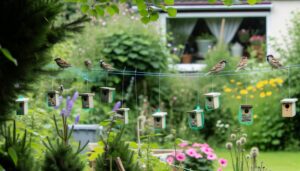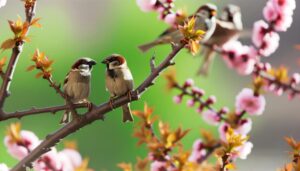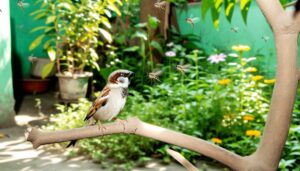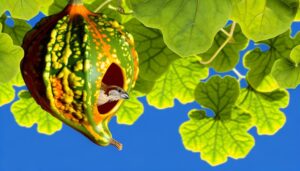Take 5 Essential Steps to Care for a House Sparrow Egg
To care for a house sparrow egg, first make sure it originates from an active nest with consistent adult presence. Use an incubator with a digital thermostat, maintaining 37.5°C to 38.0°C and humidity levels at 40% to 50%.
Turn the egg regularly to prevent yolk adhesion. Employ candling to track embryonic development.
As hatching approaches, monitor for peeping sounds and shell integrity. Post-hatch, provide a high-protein diet and adequate hydration, maintaining a warm environment.
Each step is essential for optimal embryonic growth and successful hatching, revealing further crucial techniques in avian egg care.
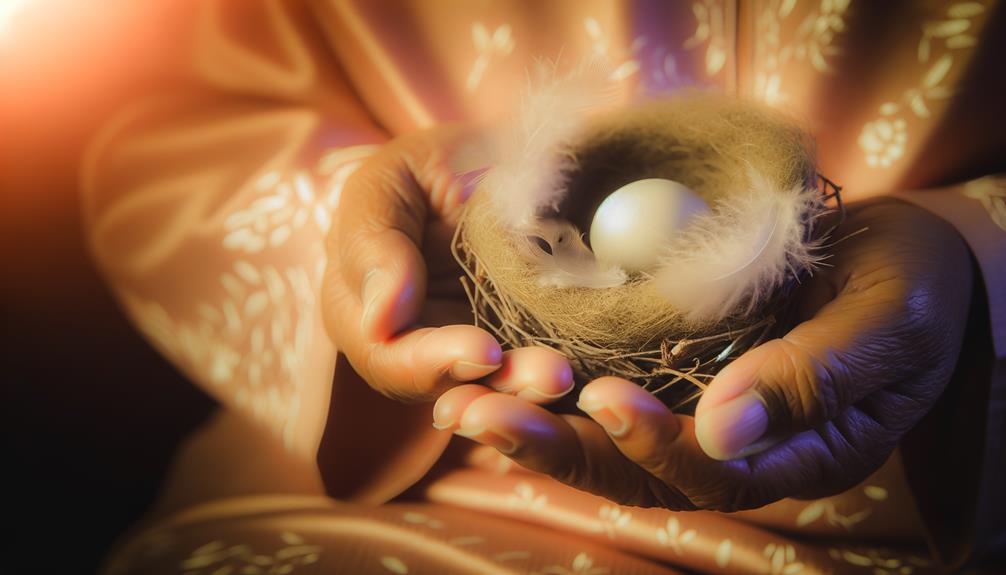
Key Takeaways
- Ensure the incubator maintains a stable temperature of 37.5°C to 38.0°C and humidity levels between 40% to 50%.
- Turn the egg gently multiple times a day to prevent the yolk from sticking to the shell.
- Use candling to monitor the embryo's development and intervene if necessary.
- Maintain consistent ventilation and monitor gas exchange within the incubator.
- Post-hatch, keep the chick warm and provide a high-protein diet and hydration through a dropper.
Finding a Suitable Egg
Locating a viable house sparrow egg requires careful observation and identification of nests that are active and well-maintained. House sparrow nests are typically built in cavities or sheltered areas. Observers should take note of frequent adult activity, which indicates an active nest.
Eggs are often speckled and measure approximately 2 cm in length. Viability can be assessed by gently candling the egg with a focused light source, revealing a developing embryo if present. Data indicates eggs found in nests with consistent adult presence have a higher likelihood of viability.
Additionally, making sure the nest is free from parasites and environmental hazards is essential for selecting a suitable egg. Detailed scrutiny of these factors guarantees the selection of a healthy, viable egg.
Setting Up an Incubator
To create perfect conditions for the development of a house sparrow egg, it is crucial to set up an incubator with precise control over temperature, humidity, and ventilation. Begin by selecting a high-quality incubator equipped with a digital thermostat and hygrometer for accurate monitoring.
The incubator should maintain a stable temperature of approximately 37.5°C (99.5°F) and relative humidity around 50-55%. Make sure the incubator has adequate ventilation to allow for proper gas exchange, which is critical for embryonic respiration.
Position the egg on an appropriate substrate that mimics natural nesting materials, ensuring it is gently rotated to avoid adhesion of the embryo to the shell. This meticulous setup promotes optimal embryonic growth and successful hatching.
Monitoring Temperature and Humidity
To guarantee successful incubation of a house sparrow egg, it is essential to maintain an ideal temperature range of 37.5°C to 38.0°C.
Precise control of humidity levels, ideally between 40% to 50%, is equally important to support embryonic development and prevent desiccation.
Continuous monitoring through calibrated sensors can provide detailed data to achieve these conditions consistently.
Optimal Temperature Range
Maintaining an ideal temperature range of 37.5°C to 38.5°C is important for the successful incubation of house sparrow eggs, as deviations can greatly impact embryo development. Temperature monitoring should be conducted using a precise digital thermometer, with readings taken at regular intervals to guarantee stability.
Research indicates that temperatures falling below 36°C can slow embryonic growth, while temperatures exceeding 40°C can be fatal. Incubation devices should include a reliable thermostat to minimize fluctuations. Additionally, it is necessary to ensure even heat distribution within the incubator to prevent localized temperature variations.
Consistent adherence to this best range fosters proper embryonic development, leading to higher hatching success rates and healthier hatchlings.
Maintaining Proper Humidity
In addition to temperature regulation, maintaining an appropriate humidity level between 50% and 55% is crucial for the proper development and hatching of house sparrow eggs. Insufficient humidity can cause desiccation, while excessive humidity might promote fungal growth.
To uphold ideal conditions, consider the following:
- Hygrometer Usage: Regularly monitor humidity with a hygrometer to ensure precise management.
- Water Source: Place a small water container inside the incubator to sustain the necessary humidity.
- Ventilation Adjustments: Modify incubator ventilation if humidity levels deviate from the optimal range.
These measures are essential to create a stable microenvironment conducive to embryonic development. Accurate humidity control, coupled with consistent temperature regulation, greatly enhances the likelihood of successful hatching.
Turning the Egg
Proper egg rotation is crucial for the development of a house sparrow embryo, as it guarantees even nutrient distribution and prevents the yolk from adhering to the eggshell. Empirical studies indicate that turning the egg at least three to five times daily can greatly enhance embryonic viability.
The rotation should be gentle, ideally tilting the egg approximately 45 degrees from its initial position. This process mimics the natural behavior of parent birds and ensures best metabolic function within the egg. Failure to consistently rotate can lead to developmental anomalies or embryo mortality.
Utilize a calibrated incubator with automatic turning capabilities for precision, or manually rotate the egg at consistent intervals to maintain uniform conditions.
Candling to Check Development
To monitor the embryonic development of a house sparrow egg, candling is an important technique that involves illuminating the egg with a bright light to visualize internal structures and assess viability. Conducted in a dark room, this method helps identify key developmental stages:
- Day 3-4: Embryo appears as a small dark spot with visible blood vessels.
- Day 7-10: Increased vascularization, embryo growth, and movement.
- Day 14-17: Nearly full-term embryo, occupying most of the egg with reduced visibility of blood vessels.
These observations are necessary for ensuring proper development and detecting any anomalies. Utilization of a high-intensity LED light source is recommended for best clarity. Frequent candling allows for timely interventions if developmental issues are detected.
Signs of Impending Hatching
As the hatching time approaches, several indicators can be observed, including changes in eggshell coloration, increased movement within the egg, and audible peeping sounds.
Eggshells may become more translucent or exhibit minor cracks, indicating the embryo's readiness to emerge. Additionally, the embryo's movement may be visually detectable, and peeping sounds can often be heard as the chick begins to break through the shell.
Eggshell Color Changes
Observing the subtle color changes in the eggshell of a house sparrow, such as a shift from a uniform hue to a more mottled appearance, can be a significant indicator of impending hatching. These alterations are critical in predicting the hatching timeline and ensuring appropriate care.
Notable changes include:
- Gradual Darkening: The eggshell may exhibit a progressive darkening, especially around the air sac region.
- Increased Mottling: The once homogeneous shell may develop sporadic spots, indicating thinning of the shell as the chick prepares to emerge.
- Translucency Near the End: Enhanced translucency may occur, particularly at the broader end of the egg, revealing internal structures.
Monitoring these shifts allows caretakers to anticipate hatching and make necessary preparations for the chick's emergence.
Movement Within Egg
In addition to changes in eggshell coloration, caretakers should also pay close attention to any subtle movements within the egg, which serve as a definitive sign of imminent hatching. These movements are typically observed as gentle rocking or slight vibrations caused by the embryo repositioning itself. Detailed observations indicate that these movements generally occur within the final 24-48 hours before hatching.
Monitoring these subtle shifts can provide crucial data regarding the embryo's vitality and readiness to emerge. Caretakers should utilize a well-lit environment and magnification tools to detect these minute movements accurately. Documenting the frequency and intensity of these movements can offer invaluable insights into the developmental stage and overall health of the house sparrow embryo.
Audible Peeping Sounds
Audible peeping sounds emanating from within the egg are a crucial indicator of the hatching process, typically manifesting 24-48 hours before the chick emerges. This phenomenon can be attributed to the chick's increasing metabolic activity and respiratory demands, necessitating vocalization. Caretakers should remain vigilant for these sounds as they signify impending hatching.
Key indicators include:
- Frequency: Regular intervals of peeping every few minutes reflect healthy embryonic development.
- Intensity: Gradually increasing volume and urgency suggest the chick is nearing the hatching phase.
- Consistency: Persistent peeping without long pauses is a positive sign of essentiality.
Monitoring these auditory cues allows for timely intervention if necessary, ensuring prime conditions for the chick's successful emergence.
Assisting the Hatch
Successful hatching assistance for a house sparrow egg requires careful monitoring of humidity levels, temperature, and shell integrity to guarantee ideal conditions for the chick's emergence. Best humidity levels should be maintained between 60-65%, as deviations can lead to either desiccation or drowning of the chick.
Temperature should be consistently regulated at approximately 37.5°C (99.5°F) to prevent developmental anomalies. Vigilant observation of the eggshell for any signs of external pipping, such as small cracks or peck marks, is essential.
Should the chick exhibit prolonged difficulty in breaking free, minimal manual intervention, such as gently enlarging the pip hole, may be necessary. However, undue interference can cause harm, necessitating a delicate balance between assistance and natural hatching processes.
Post-Hatch Care
Following the chick's successful emergence from the shell, immediate attention must be directed towards maintaining ideal environmental conditions and meeting the chick's initial nutritional and hydration needs.
Key aspects of post-hatch care include:
- Temperature Regulation: Maintain an ambient temperature of 35-37°C (95-98.6°F) using a controlled heat source to mimic the warmth provided by the parent bird.
- Nutritional Requirements: Administer a high-protein formula, specifically designed for passerines, every 20-30 minutes during daylight hours to support rapid growth and development.
- Hydration: Provide hydration by offering small amounts of water via a dropper, carefully monitored to prevent aspiration.
Observations should be meticulously recorded to track developmental milestones and identify any early signs of distress or illness.
Conclusion
To sum up, the journey of nurturing a house sparrow egg to successful hatching is akin to traversing a maze of precise scientific protocols. One must exhibit the steadiness of a neurosurgeon, the vigilance of a night watchman, and the patience of a saint.
Should one falter in monitoring temperature, humidity, or the intricate dance of egg-turning, the consequences could be dire. Therefore, the endeavor serves as a humbling reminder of nature's intricate balancing act, best left to the avian progenitors themselves.

